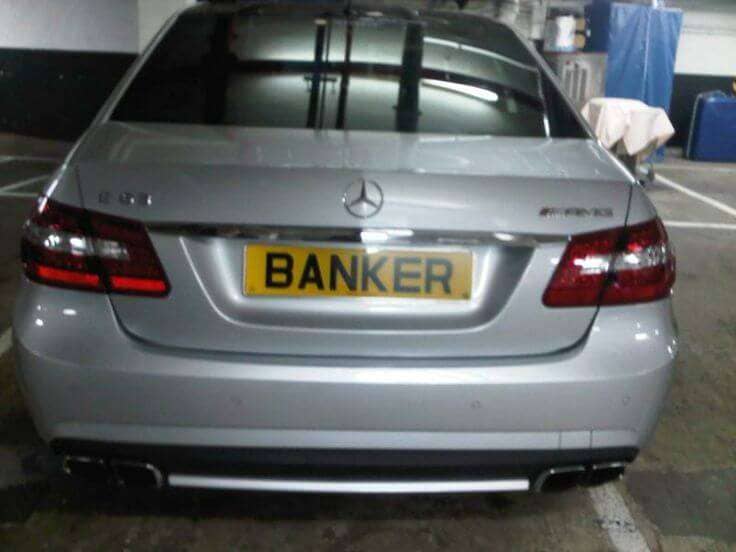By Mark Simpson
Personalised number plates are the pits. The egotism of them! The silliness of them! The waste of them! The motoring equivalent of a sovereign necklace, their only value is warning everyone that the driver ahead is a BI6 DCK.
Or so I used to think. And I suspect many of you may have done so too.
Personalised plates or ‘vanity plates’ as they are sometimes called are booming. According to the Driver & Vehicle Licensing Agency almost 350,000 registrations were sold over the past year. More than four times the total in the mid-1990s – earning a pretty £102 million for the treasury.
It’s estimated that as many as 20% of cars are now fitted with personalised plates, up from less than 1% a few decades ago. Having a vanity plate no longer means you must be a plonker. Unless you think every fifth person you meet is a plonker. In which case you are probably the plonker.
To make matters worse for the vanity plate hater, there has been a 20-fold rise in the value of rare plates over the last two decades. ‘One and two’ plates (one number, two letters) that were purchased for £3000-5000 in the early 90s are now worth a cool c. £60,000. Very rare plates meanwhile can fetch absurd sums. Last year an ‘007’ plate from Guernsey fetched £240,000 at public auction. A couple of years ago ’25 O’ – coveted by 250 GTO owners – sold for £518,000.
Vanity plates add to the gaiety of the nation, are increasingly popular, raise money for the Treasury – £2.3 billion since they began to be sold in 1989 – and can represent a very good investment. In addition to being something you’ll never have to go back to check when it comes to entering your registration at a car park ticket machine or checking in at a hotel.
So why the hate? Envy may be part of it – and many of us can’t afford private plates and so will happily look for reasons to discount people who can. But we don’t necessarily hate people for having flash, or modded cars. Both of which are attempts to ‘make a statement’ and achieve ‘status’. Big exhausts, low suspensions, klaxons and even millionaire marques tend to make us smile rather than spit.
I suspect it’s because we tend to personalised plates as a form of cheating. Blasphemy, even. By default, a UK registration plate will accompany a vehicle throughout its lifetime. It is not attached to the owner. Unique as DNA, it is also usually the only bit of the car that is personalised – but not, we seem to think, by the owner. But rather, by the DVLA. Otherwise known as God. Which, by the way, bans the word ‘GOD’ from personalised number plates.
The DVLA giveth, and the DVLA taketh away.
Likewise, cars used by the reigning monarch – The Defender of the Faith – on official business have no registration number.
Perhaps it’s a hangover from the age of deference and feudalism, but many of us, myself included until I actually started researching the subject, seem to think in effect that number plates should only be allocated not purchased.
Registering vehicle and fitting a registration mark has been compulsory in the UK since 1903, in order to make it easy to trace a vehicle involved in an accident or law-breaking – and also easier to tax them. A kind of motoring Doomsday Book. Originally the only plates allowed to be transferred were ordinary registrations. But in 1989 the DVLA began selling personalized registrations unrelated to the registration districts, opening the egomaniacal flood gates.
In the age of ‘personal branding’ on social media and in fact all walks of life, it seems likely that personalised number plates are only going to become even more common. When people obsess over personalising their mobiles, why spend much more money on something you are going to be seen driving/wearing if it isn’t going to have your signature on it?
The nearest I came to having a ‘personalised’ number plate was when I happened to buy a used car with a registration that began with my first initial, followed by my (then) age. The second part started with my second initial. No one else would ever know it was ‘personalised’ – and in fact it was only after I bought the car that I realised the significance myself. But I’d be lying if I said I didn’t like it. It made the car feel more ‘mine’. So much so that when the new owner sent me a photo of it I felt a little bit jealous – of the plate.
Not that this stopped me still dissing people with properly personalised number plates. After all, mine had arrived by divine DVLA/Exchange & Mart lottery. Theirs by way of some grubby financial arrangement.
Of course, personalised plates can sometimes be too personal. DVLA censors meet every six months to decide on potentially offensive registration plates, and there is a long list of banned and suppressed combinations for political, racial, sexual and religious reasons. Some – such as BI6 DCK – are banned simply because of poor taste.
The DVLA might not actually be God, you see, but it is a bit like your maiden auntie.
